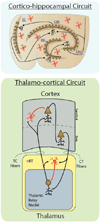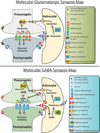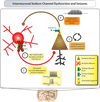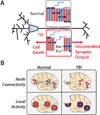From Molecular Circuit Dysfunction to Disease: Case Studies in Epilepsy, Traumatic Brain Injury, and Alzheimer's Disease
- PMID: 25948650
- PMCID: PMC4641826
- DOI: 10.1177/1073858415585108
From Molecular Circuit Dysfunction to Disease: Case Studies in Epilepsy, Traumatic Brain Injury, and Alzheimer's Disease
Abstract
Complex circuitry with feed-forward and feed-back systems regulate neuronal activity throughout the brain. Cell biological, electrical, and neurotransmitter systems enable neural networks to process and drive the entire spectrum of cognitive, behavioral, and motor functions. Simultaneous orchestration of distinct cells and interconnected neural circuits relies on hundreds, if not thousands, of unique molecular interactions. Even single molecule dysfunctions can be disrupting to neural circuit activity, leading to neurological pathology. Here, we sample our current understanding of how molecular aberrations lead to disruptions in networks using three neurological pathologies as exemplars: epilepsy, traumatic brain injury (TBI), and Alzheimer's disease (AD). Epilepsy provides a window into how total destabilization of network balance can occur. TBI is an abrupt physical disruption that manifests in both acute and chronic neurological deficits. Last, in AD progressive cell loss leads to devastating cognitive consequences. Interestingly, all three of these neurological diseases are interrelated. The goal of this review, therefore, is to identify molecular changes that may lead to network dysfunction, elaborate on how altered network activity and circuit structure can contribute to neurological disease, and suggest common threads that may lie at the heart of molecular circuit dysfunction.
Keywords: Alzheimer’s disease; circuits; epilepsy; molecular dysfunction; traumatic brain injury.
© The Author(s) 2015.
Conflict of interest statement
The author(s) declared no potential conflicts of interest with respect to the research, authorship, and/or publication of this article.
Figures






Similar articles
-
Traumatic brain injury triggers APP and Tau cleavage by delta-secretase, mediating Alzheimer's disease pathology.Prog Neurobiol. 2020 Feb;185:101730. doi: 10.1016/j.pneurobio.2019.101730. Epub 2019 Nov 25. Prog Neurobiol. 2020. PMID: 31778772
-
Traumatic Brain Injury Increases the Expression of Nos1, Aβ Clearance, and Epileptogenesis in APP/PS1 Mouse Model of Alzheimer's Disease.Mol Neurobiol. 2016 Dec;53(10):7010-7027. doi: 10.1007/s12035-015-9578-3. Epub 2015 Dec 15. Mol Neurobiol. 2016. PMID: 26671618
-
Glucose metabolism: A link between traumatic brain injury and Alzheimer's disease.Chin J Traumatol. 2021 Feb;24(1):5-10. doi: 10.1016/j.cjtee.2020.10.001. Epub 2020 Nov 3. Chin J Traumatol. 2021. PMID: 33358332 Free PMC article. Review.
-
Activity disruption causes degeneration of entorhinal neurons in a mouse model of Alzheimer's circuit dysfunction.Elife. 2022 Dec 5;11:e83813. doi: 10.7554/eLife.83813. Elife. 2022. PMID: 36468693 Free PMC article.
-
Corticothalamic network dysfunction and Alzheimer's disease.Brain Res. 2019 Jan 1;1702:38-45. doi: 10.1016/j.brainres.2017.09.014. Epub 2017 Sep 15. Brain Res. 2019. PMID: 28919464 Free PMC article. Review.
Cited by
-
Neuroendocrine Abnormalities Following Traumatic Brain Injury: An Important Contributor to Neuropsychiatric Sequelae.Front Endocrinol (Lausanne). 2018 Apr 25;9:176. doi: 10.3389/fendo.2018.00176. eCollection 2018. Front Endocrinol (Lausanne). 2018. PMID: 29922224 Free PMC article. Review.
-
Mechanisms Involved in Epileptogenesis in Alzheimer's Disease and Their Therapeutic Implications.Int J Mol Sci. 2022 Apr 13;23(8):4307. doi: 10.3390/ijms23084307. Int J Mol Sci. 2022. PMID: 35457126 Free PMC article. Review.
-
Flexibility of in vitro cortical circuits influences resilience from microtrauma.Front Cell Neurosci. 2022 Dec 16;16:991740. doi: 10.3389/fncel.2022.991740. eCollection 2022. Front Cell Neurosci. 2022. PMID: 36589287 Free PMC article.
-
Neurodegenerative pathways as targets for acquired epilepsy therapy development.Epilepsia Open. 2020 Mar 12;5(2):138-154. doi: 10.1002/epi4.12386. eCollection 2020 Jun. Epilepsia Open. 2020. PMID: 32524040 Free PMC article. Review.
-
From spreading depolarization to blood-brain barrier dysfunction: navigating traumatic brain injury for novel diagnosis and therapy.Nat Rev Neurol. 2024 Jul;20(7):408-425. doi: 10.1038/s41582-024-00973-9. Epub 2024 Jun 17. Nat Rev Neurol. 2024. PMID: 38886512 Review.
References
-
- Abramov E, Dolev I, Fogel H, Ciccotosto GD, Ruff E, Slutsky I. Amyloid-beta as a positive endogenous regulator of release probability at hippocampal synapses. Nat Neurosci. 2009;12:1567–1576. - PubMed
-
- Alonso AC, Grundke-Iqbal I, Iqbal K. Alzheimer’s disease hyperphosphorylated tau sequesters normal tau into tangles of filaments and disassembles microtubules. Nat Med. 1996;2:783–787. - PubMed
-
- Amaral DG, Witter MP. The three-dimensional organization of the hippocampal formation: a review of anatomical data. Neuroscience. 1989;31:571–591. - PubMed
-
- Annegers JF, Coan SP. The risks of epilepsy after traumatic brain injury. Seizure. 2000;9:453–457. - PubMed
Publication types
MeSH terms
Substances
Grants and funding
LinkOut - more resources
Full Text Sources
Other Literature Sources
Medical

